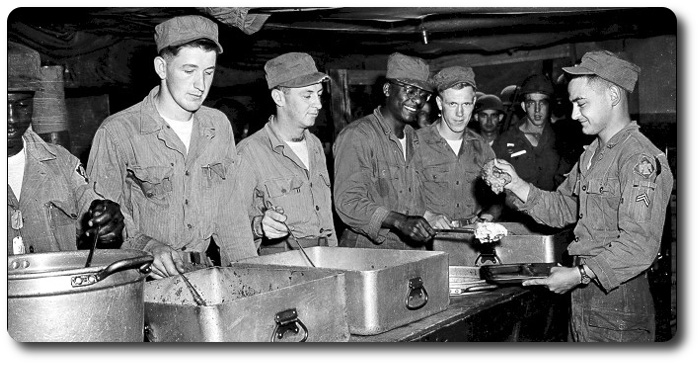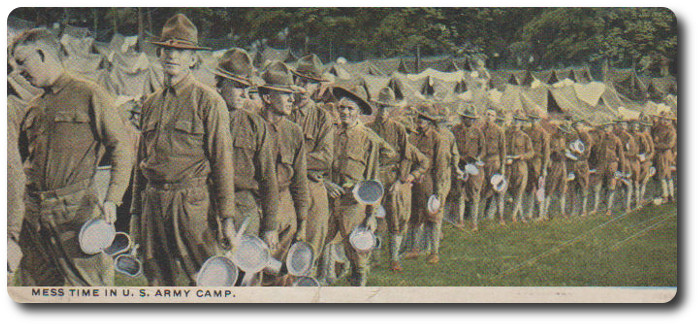Topic: Army Rations

Historical US Amy Rations
The Soldier and His Food, prepared by The Women's Interest Section, War Department, Bureau of Public Relations, 1942
The story of the development of the Army mess presents a pageant of foods, all the way from hardtack to French dressing.
Revolutionary War
On November 4, 1775, the day after creating the office of General, and electing George Washington to fill that post, the Continental Congress passed a resolution: "That there be one Commissary General of Stores and Provisions."
The ration consisted of:
- 1 pound beef, or 3/4 pound pork, or 1 pound salt fish per day.
- 1 pound bread or flour per day.
- 3 pints peas or beans per week.
- 1 pint milk per day.
- 1/2 pint rice or 1 pint Indian Meal per week.
- 1 quart spruce beer or cider per day, or 9 gallons molasses per 100 men per week.
- 3 pounds candles per 100 men per week, for guards.
- 8 pounds hard soap per 100 men per week.
A legislative history, printed in 1877, from which this report is taken, points out that the reference to milk was interesting, for it was not available that first winter and from then on was not mentioned in the ration for over 100 years.
In 1799 the liquor was discontinued, but the Commander in Chief of the Army or the Commanding Officer of any detachment was authorized to issue to the troops "from time to time, rum, whiske”y, or other ardent spirits (not to exceed 1/2 gill per man per day except on extraordinary occasions)."
In those "good old days", the soldier was issued his ration uncooked each day. It was to be prepared by himself, later, over die glowing embers of the camp fire.
War of 1812
1812 brought a slight change in the ration allowance.
- Per man per day:
- 1 1/4 pounds beef or 3/4% pound pork.
- 18 ounces bread or flour.
- 1 gill rum, whiskey, or brandy.
- Per 100 rations:
- 2 quarts salt.
- 4 quarts vinegar.
- 4 pounds soap.
- 1 1/2 pounds candles.
1818
In a southern climate the ruling became "Give molasses in lieu of whiskey and beer, and add to the ration l/2 pint of peas, beans, or rice per day." Orders were given to cultivate garden vegetables at permanent posts. The Secretary of War, J. C. Calhoun, made a long speech about Army feeding. He felt the food should be improved in both quantity and quality and urged that spirits be dispensed with.
A quaint nutrition note was issued: "Pickles, on account of the vegetable acid, are both a pleasant and healthy stimulant to the stomach."
War between the States
There were three rations in effect during this period, all substantially the same, with a decrease in this commodity balancing an increase in that one.
Basically, the ration consisted of beef, flour, dry beans, green coffee, sugar, vinegar, and salt. Yeast powder and black pepper were the outstanding additions. Soap and candles were still included. The history of Army feeding recalls that during the Civil War rations were "not always available" and that frequently the soldier had to live by foraging upon the surrounding country.
Spanish-American War
The significant change in this ration was the disappearance of the much disliked hard tack.

World War I
At the time the United States entered the World War, the Army was using a Garrison ration established in 1913. This was used in the continental United States throughout the war, except that in 1918 two articles (sweet potatoes and corn meal) were added to the list of substitute articles
- Beef – 20 oz.
- Flour – 18 oz.
- Baking powder – .08 oz.
- Beans, dry – 2.4 oz.
- Potatoes, fresh – 20 oz.
- Prunes – 1.28 oz.
- Syrup – .32 oz.
- Coffee, R. & G – 1.12 oz.
- Sugar – 3.2 oz.
- Milk, evaporated – .5oz.
- Vinegar gill – .16 oz.
- Salt – .64 oz.
- Pepper, black – .04 oz.
- Cinnamon, ground – .014 oz.
- Butter – 0.5 oz.
- Lard – .64 oz.
- Flavoring extract, lemon – .014 oz.
- Soap – .64 oz.
- Candle – .24 oz.
The Army’s food bill for 1917-18 was $727,092,430.44. The daily cost of feeding a soldier was 26 cents.
Today’s soldier eats 48 cents worth of food a day. Today’s soldier gains, on the average, from 6 to 10 pounds during the first few months of camp life. Today’s soldier is the best fed soldier in the world and in history.
But today’s soldier, like every soldier in history and in the world, loves to get a cake from home.

